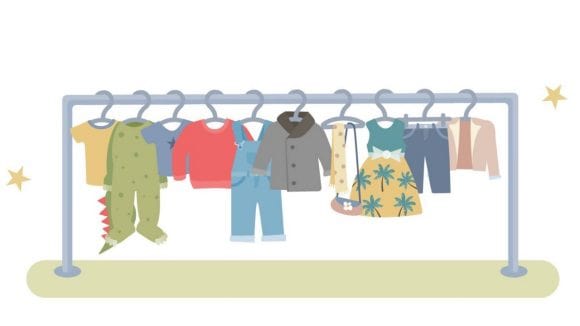Is your child always chasing the latest fashions?
To stay trendy, they often buy inexpensive clothes with their pocket money. How to talk about this with your child.

![]()
header.search.error
To stay trendy, they often buy inexpensive clothes with their pocket money. How to talk about this with your child.

Young people want to make their own buying decisions. They really don’t like being told what clothes to buy. And these days, fashionable clothing and accessories can be had for very little money. Though the quality and production conditions may be questionable, fast fashion does have its finger on the pulse of a young target group with a limited budget. As parents, we want our children to pay greater attention to quality over quantity. But then we’re hardly paragons of virtue ourselves. Let’s be honest, how many clothes are currently hanging in our own closets that we’ve never or rarely worn? We’ve all bought something we later regretted. Mindful consumption is easier said than done. What can you do to help your teenager avoid repeating poor decisions when buying clothes?
Talk about how you shop
What do you look for when buying new clothing? What matters, what’s a no-go? Talk to your child before you give them their first Jugendlohn or they start earning their own money from a side job. Teenagers need to learn for themselves what to buy. But knowing how adults think can be helpful. Don’t neglect to listen to them. What does your child look at when looking for new clothes? Presumably they won’t share your preferences – you should respect that. But you can help them to understand that the pleasure they’ll have from a high-quality, sustainable item will last longer than any short-term kick from half a dozen cheap items that will be “out” by the morning.
Admit your mistakes
We make buying decisions daily – decisions which in retrospect were wrong. Don’t point out your child’s poor choices, but act instead as a good example and talk about your own missteps, whether it was some foul-tasting yogurt or a new winter coat. Have you ever given into the pressure to conform and bought into a fashion trend only to realize to your dismay later, “Oh no! That’s not me at all”? By being open, you show there’s nothing wrong with making mistakes, and your child may feel more comfortable talking about their own mistaken purchases. Understanding is the first step to better choices.
Clean out your closets together
Turn decluttering your wardrobe into a shared ritual. You’ll likely stumble across some clothes you no longer find quite so stylish – and you can both share a laugh. Doing this can help your child see why it makes sense to buy items that won’t fall out of fashion so quickly. You might also discover some long-forgotten, now timeless pieces that can become your favorites again. The both of you could drop off the sorted items at a second-hand or vintage clothing store. Or maybe you’d rather set up a family stand at the local flea market?
The experimental method
Lived examples are more powerful than words. Buy two similar sweaters: one that you believe to be of high quality, and a cheaper version that’s more questionable. You might not even have to buy new sweaters, but already have two similar items of different quality in your closet. Decide together which item has been worn the longest and most often. Is the cheaper version misshapen, does it have holes or a stretched collar? Such an experiment makes differences in quality vivid and shows your children that well-thought-out purchases bring more pleasure than trendy snap decisions.
The highlights in a nutshell
UBS’s educational principles
This article was written in collaboration with educator Marianne Heller, who has years of experience in teaching financial education and debt prevention programs for children and young people.

Subscribe to the Kids newsletter
Check out the latest articles on teaching kids about money and discover great contests and info about the UBS Kids Cup.